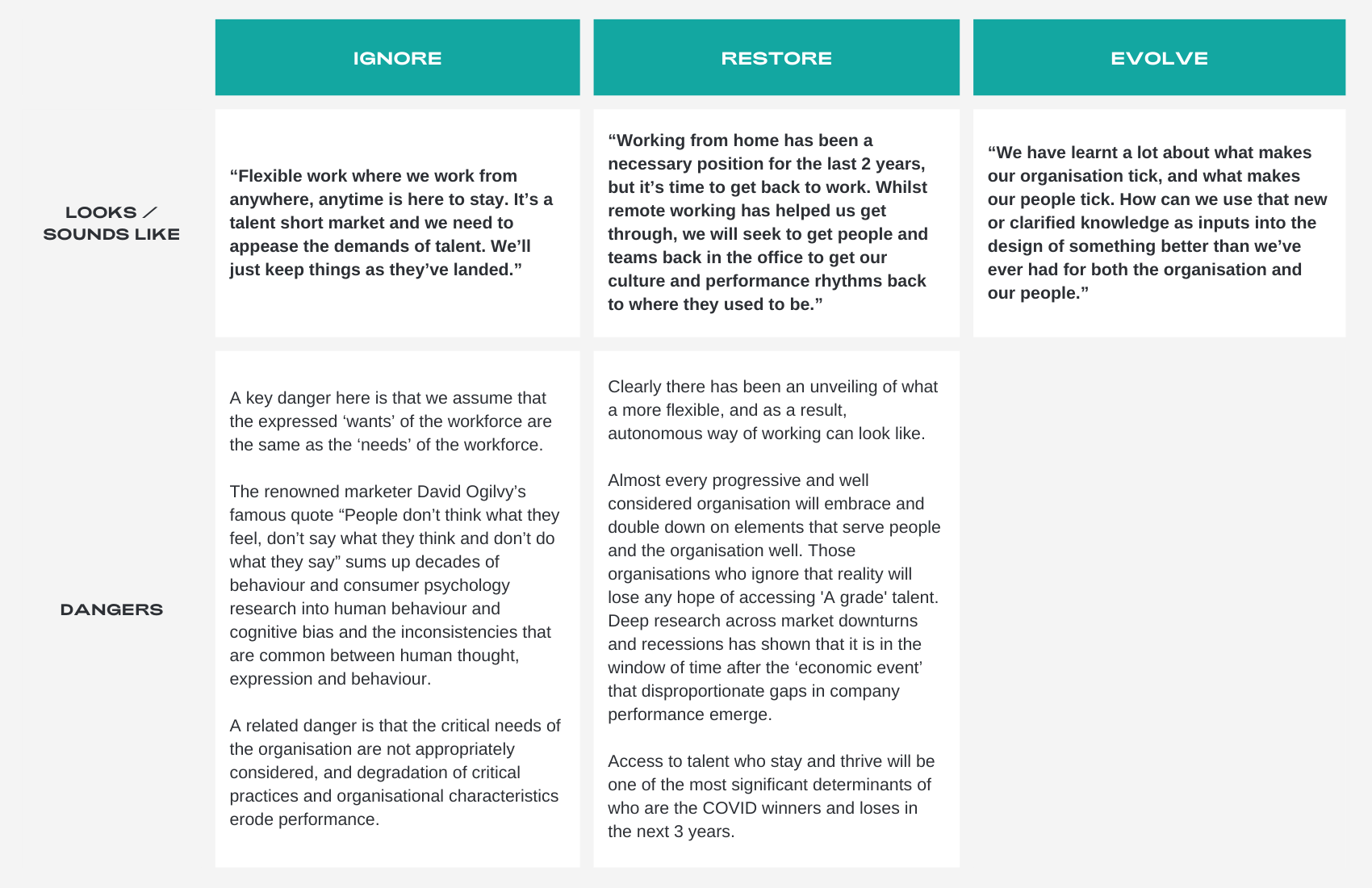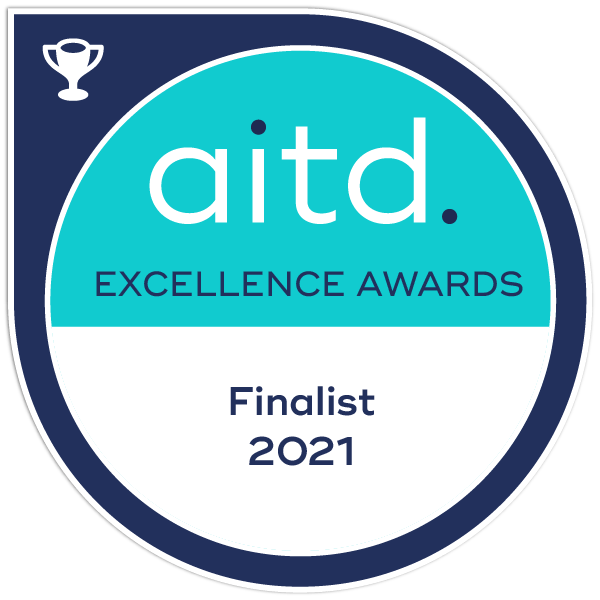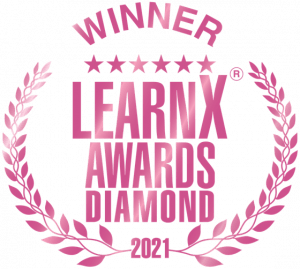IGNORE, RESTORE OR EVOLVE? THE NEW WORKPLACE DILEMMA
Dylan Flavell • April 27, 2022
NOW IS THE TIME FOR ORGANISATIONS TO MAKE SOME CRUCIAL DECISIONS.
Ignore, Restore or Evolve? That appears to be dilemma faced by many organisations trying to navigate critical talent, culture and workforce issues ‘post pandemic’. With the inertia caused by lockdowns and health regulations quickly evaporating over the past few months, it is being replaced by frenetic organisational activity focussed on transforming or getting organisations ‘back on track’.
This reality poses a culture, talent and workforce dilemma for organisations in their response to this rapidly changing context:
- Do we Ignore these changes and just retain the default work practices that have set in across the past two years
- Do we seek to ‘turn back the clock’ and Restore pre pandemic work patterns and expectations, or;
- Do we actively seek to Evolve our culture and ways of working.
Our work across multiple government and large corporates across Australia has seen a range of responses that fall into these 3 categories.
| IGNORE | RESTORE | EVOLVE | |
|---|---|---|---|
| LOOKS / SOUNDS LIKE | “Flexible work where we work from anywhere, anytime is here to stay. It’s a talent short market and we need to appease the demands of talent. We’ll just keep things as they’ve landed.” | “Working from home has been a necessary position for the last 2 years, but it’s time to get back to work. Whilst remote working has helped us get through, we will seek to get people and teams back in the office to get our culture and performance rhythms back to where they used to be.” | “We have learnt a lot about what makes our organisation tick, and what makes our people tick. How can we use that new or clarified knowledge as inputs into the design of something better than we’ve ever had for both the organisation and our people.” |
| DANGERS | A key danger here is that we assume that the expressed ‘wants’ of the workforce are the same as the ‘needs’ of the workforce. The renowned marketer David Ogilvy’s famous quote “People don’t think what they feel, don’t say what they think and don’t do what they say” sums up decades of behaviour and consumer psychology research into human behaviour and cognitive bias and the inconsistencies that are common between human thought, expression and behaviour. A related danger is that the critical needs of the organisation are not appropriately considered, and degradation of critical practices and organisational characteristics erode performance. | Clearly there has been an unveiling of what a more flexible, and as a result, autonomous was of working can look like. Almost every progressive and well considered organisation will embrace and double done on elements that serve people and the organisation well. Those organisations who ignore that reality will lose any hope of accessing A grade talent. Deep research across market downturns and recessions has shown that it is in the window of time after the ‘economic event’ that disproportionate gaps in company performance emerge. Access to talent who stay and thrive will be one of the most significant determinants of who are the COVID winners and loses in the next 3 years. |
WHERE TO FROM HERE
The opportunity now, regardless of the twists COVID may still present over the coming year, is to make a deliberate effort to explore what ‘Evolve’ might look like for your organisation. Our ‘Return to the Office
Playbook’ provides insights into how you might start that journey.
Our key reflections from research and our current experience are:
-
SEEK BALANCE
WHAT:
Balance across the needs of the organisation AND people is needed. Too far either way will not achieve sustainable performance or people outcomes.
HOW:
We are doing this through combining both Organisational Effectiveness & EVP lens’ to the framing of this work.
-
BE DELIBERATE
WHAT:
Be Deliberate in design efforts. That is conscious of ‘real’ research, and seek to experiment, test and learn to see what works for your organisation.
HOW:
Establishing a working group from across the business, and a defensible data set to support decision making is a great start
-
BE TRANSPARENT
WHAT:
Be transparent about the method, approach and rationale to redesign future ways of working. Where people don’t have visibility they will interpret their experience as it occurs to them.
HOW:
Show and share openly the approach to design, and ensure an appropriate set of stakeholders and influencers in the organisation are involved. They will advocate the integrity of the process to their colleagues and peers. Find ways for all staff to have a voice, if not a vote. Share the rationale for what was done, revealed and decided. Research shows that the majority, when shown the logic of a well considered approach and related actions, will find ways to align and support.
-
AVOID BINARY SOLUTIONS
WHAT:
Avoid Binary solutions, that are often in the form of ‘one size fits all’. This is crippling and not rational when so much diversity within people and organisations exists.
HOW:
Scenario test when, how and why hybrid working expectations/standards may exist between individuals, teams, functions and leaders. This may require exploring assumptions about equality and equity, and will be a key leadership challenge.
Contact
03 8618 6904
Head office
Central House
101 Moray St.
South Melbourne, VIC 3205
ABN: 99 624 232 364
All locations
Awards
newsletter subscription
Thanks for subscribing to our newsletter. Keep an eye out for our next edition in your email.
Oops, there was an error.
Please try again later.
Spring Point acknowledges the Aboriginal and Torres Strait Islander peoples as the first inhabitants and the traditional custodians of the lands where we live, learn and work.
Spring Point is committed to fostering a safe, diverse and inclusive workplace.
© Spring Point 2022








